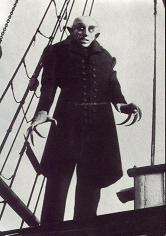Nosferatu

"Mortal terror reigned
Sickness now, then horrible death
Only Lucy knew the truth
And at her window -
Nosferatu"
Nosferatu (rarely used full title: Nosferatu, a Symphony of Horror) is the first known "vampire" movie, released in 1922. Director Friedrich W. Murnau cast Max Schreck as Count Orlok, with the veteran German character actor wearing huge pointed ears, long fangs, and completely bald... one of the most frightening characters in film history. The myth that Nosferatu was Schreck's only role is untrue: he appeared in over 20 films and a number of stage roles, all in Germany. This movie is also notable for spawning the idea that vampires can be killed by sunlight.
Nosferatu was originally intended to be a direct adaptation of Bram Stoker's Dracula, but Stoker's widow, who owned the copyright, refused permission. So the Murnau and his team changed the characters' names,[1] simplified the plot, and tried to pass Nosferatu off as an original story.
It didn't work. The film company that produced Nosferatu was forced to declare bankruptcy to avoid paying Bram Stoker's estate for copyright infringement. All copies of this film were supposed to be destroyed because of the infringement, but a Keep Circulating the Tapes mentality among fans of the film kept it from being lost. (Pre-digital movie piracy? It's Older Than You Think.) We too can see the greatness of Murnau's vision.
The myth that Schreck only appeared in this one film was perpetuated by the 2000 film Shadow of the Vampire, which portrayed Schreck as an actual vampire.
This movie is in the public domain and may be viewed in its entirety at Google Video, YouTube and the Internet Archive.
Also notable under this title: Werner Herzog's 1979 Nosferatu the Vampyre, a re-adaptation of Dracula heavily influenced by the Murnau film's iconic visuals and streamlined plot. Klaus Kinski played the title role (now back to the name "Dracula"), and it's generally considered to be almost as good as the original. Some would even call it better. Kinski would return for the 1988 sort-of-sequel Nosferatu in Venice.
- Adaptation Distillation: Despite the fact that all the names have been changed and the plot's been simplified, this is probably the best Dracula adaptation out there.
- As Long as It Sounds Foreign: The etymology of the word "nosferatu" is unclear. This movie isn't the first to use it (Stoker's novel referenced it first), but the usual origin (the Romanian word for "vampire") is false.
- Bald of Evil: Orlok.
- Bedsheet Ladder: Used by Hutter to escape Orlok's castle.
- Creepy Long Fingers
- German Expressionism
- Ghost Ship: The one Orlok takes to Germany becomes one of these when it pulls into port. Because of Orlok.
- Happily Married: Hutter and Ellen. Mind you, they are newlyweds.
- Heroic Sacrifice: Ellen deliberately lets Orlok feed on her to distract him until sunrise.
- Kill'Em All: Orlok kills everyone on the ship.
- Looks Like Orlok: Trope Namer. Quite a contrast to the suave, attractive vampires that make up so much of the rest of vampire fiction (and a bit of a diversion from the old cranky man that Dracula himself started out as).
- Love Transcends Spacetime: At the very moment when Orlok is readying himself to feed, fatally, on Hutter, Ellen has a sudden panic attack... which somehow makes the vampire back down and leave Hutter alive.
- Misplaced Wildlife: The "Werewolf" that we see roaming around outside the inn Hutter stops at for the night is actually a hyena.
- Only the Pure of Heart: Only an innocent young woman's willing sacrifice of her blood to distract the vampire from the coming dawn can destroy him.
- Our Vampires Are Different: As noted above, this film originated the idea that vampires burn in sunlight. Also, Schreck's vampire is rather uniquely portrayed as a rat-like monster and the personification of pestilence.
- Pivotal Wakeup: The Trope Maker, and one of the creepiest moments in the movie.
- Red Right Hand: See Looks Like Orlok above.
- The Renfield: Knock.
- Royal Decree: Plague victims are decreed to be kept out of the hospital to stop the spread of the disease.
- Soundtrack Dissonance: Some versions of the film feature a near-constant usage of a strange, cheerful little tune that sounds more like it would belong in an old Mickey Mouse cartoon than a classic horror movie. It becomes increasingly hard to get into the mood of the film when this song is in nearly every other scene, even in perfectly innocuous ones, such as the simple act of walking up stairs.
- Star-Crossed Lovers
- Supporting Protagonist: Hutter. His wife Ellen's presence protects him from Orlok while he's in Transylvania, and it is only through her sacrifice that Orlok is killed.
- Swarm of Rats: Orlok brings them with him aboard his ship.
- Vampire Bites Suck: Orlok's needle-like incisors leave two small pinprick-holes in the victim's throat.
- Weakened by the Light: Sunlight makes Orlok catch fire and disappear (as noted above, this film is the Trope Maker).
- Who Wants to Live Forever?: A major theme of the Herzog/Kinski remake. It's not so much that he's outliving his loved ones, it's that no one could ever love a monster like him. And living forever, eternally unloved, is almost unbearable. It's possibly the most tragic interpretation of the Dracula story ever.
- ↑ Some later English-language prints "restore" the character names to their Dracula originals.